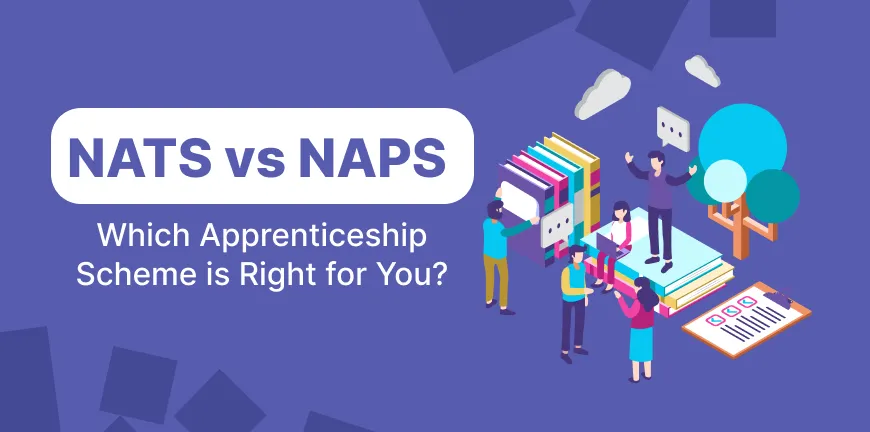
Work from Home vs Work from Office: Which One Boosts Productivity?
08/10/2025
What Is Work Culture? Definition, Components and Examples
12/10/2025Building a workforce that is future-ready is the priority for employers. To help realise the same, our country offers robust apprenticeship frameworks. Two of the most important ones are the National Apprenticeship Training Scheme (NATS) and the National Apprenticeship Promotion Scheme (NAPS). These apprenticeship schemes were designed to address the growing skills gap through practical, on-the-job training. However, there is a significant difference between NAPS and NATS in a few areas, such as their target audience, financial support received from the government, skill grade of apprentices, and more.
Employers can undertake the NATS/NAPS program, depending on skill requirements/ candidate qualification/other factors based on their business needs. Here is a guide of NAPS vs NATS to help employers make their decision as to which one to choose.
What is NATS?
NATS stands for National Apprenticeship Training Scheme, which is an apprenticeship scheme introduced by the Indian Government in 2006 to provide skill training to help people find jobs in the formal sector and vocational skill training for employment in private institutions. NATS was introduced to enable employers
- to develop a skilled workforce to meet future challenges posed by technological or regulatory changes.
- To create job opportunities in the sustainable industry for communities that are otherwise not given equal opportunities. These jobs are designed in a manner that aligns with office jobs. Preference is given to women and those engaged in traditional roles.
- To create jobs and enable youth to take up self-employment and become entrepreneurs.
What are the Key Features of NATS?
Several features set the National Apprenticeship Training Scheme apart as a one-of-a-kind and very innovative apprenticeship training scheme.
- Stipend Paid is aligned to the minimum rates prescribed under the Act for each category of apprentice – Graduate/Technician Diploma/Technician Vocational, etc.
- At the end of the training period, the apprentices are issued a Certificate of Proficiency by the Government of India, which can be registered at all employment exchanges across India as valid employment experience.
- There is no guarantee of employment after completion of training as an apprentice. For the implementation of the NATS Scheme, Board of Apprenticeship Training (BOAT) regional offices conduct and organize Apprenticeship Fairs held periodically, which provide students and establishments a valuable opportunity to meet their training/workforce needs.
- The scheme provides a period of 1 year to observe the performance of the candidate before making them regular, full-time employees.
- In the National Apprenticeship Training Scheme, the government pays employers who have taken up the scheme 50% of the minimum payment that must be made to the apprentices for their services.
- The training scheme ensures that there is no shortfall of workforce in the organization to accomplish the tasks.
- The scheme allows establishments to address even future requirements for human resources.
- The Government offers designated trades and optional trades by private institutions. Under this scheme, both optional and designated trades are addressed.
- If an establishment is operating its business in several states of India, then it can operate on a national basis.
What is NAPS?
NAPS refers to the National Apprenticeship Promotion Scheme. The primary objective of the NAPS Scheme is to promote apprenticeship training to develop the skills of individuals through on-the-job training. This not only helps individuals find suitable jobs but also addresses the growing critical skills gaps in companies, enabling them to build and hire a skilled workforce.
One of the main intentions of the program is to promote and support apprenticeship culture by maximizing apprentices’ engagement in the micro, small, and medium enterprises (MSME) segment to build productivity.
The NAPS scheme helps in building partnerships and connecting industries and educational institutions, and also supports organizations that undertake NAPS programs.
What are the Key Features of NAPS?
Some of the Key Features of NAPS include financial benefits for employers, a double benefit of earning while learning for individuals, and more.
- The government takes the responsibility for paying 25% of the stipend that is to be paid to the apprentices or 1500 rupees per month, whichever is lower. This reduces the financial burden on employers and encourages them to hire more apprentices.
- NAPS pays for the basic training of those apprentices who do not have a prior formal training in any skill. This facilitates training of the apprentices to be job-ready before they move on to the on-the-job training.
- More and more industries are encouraged to take up the NAPS Scheme and come up with training modules that would not just help apprentices upskill but would also help the company create new in-demand job roles.
- To encourage small and medium enterprises to hire more apprentices, the government pays a larger amount. This is a win-win for both parties. The company gets access to individuals hungry to learn and thrive and individuals looking for an opportunity to learn and earn get one.
- Both employers and apprentices can register on the online portal for the apprenticeship scheme. The portal facilitates uploading of contracts, keeping a check on stipend disbursements, and monitoring of performance.
- To make sure a wide range of industries actively hire apprentices and provide employment, the government takes an interest and funds them. Some of the sectors include agriculture, retail, logistics, and IT.
How Do NATS and NAPS Differ?
The difference between NAPS and NATS mainly lies in their target audience. Some of the other things they differ in are their areas of focus, training duration, and financials. NATS focuses on hiring technical graduates, training them, and employing them for up to 3 years in some trades. NAPS focuses on equipping individuals, such as school passouts or unskilled individuals, to find jobs. The training period is also shorter in NAPS and lasts only about 6 months to 1 year.
Talking about financial benefits, in NAPS, employers from various industries, such as retail, hospitality, IT, and manufacturing, are offered greater financial incentives. This is done to encourage employment for low-skilled individuals, post-training. In NATS, the government supports paying part of the stipend.
Key Differences
| Feature | NATS | NAPS |
| Target individuals | Technical graduates & diploma holders | All sectors, school pass-outs, and reskilled individuals |
| Duration | Up to 3 years | 6 months to 1 year |
| Focus | Technical, long-term, post-education training | Various industries, short-term training, and entry-level skills training |
| Funding | Govt. supports apprentice stipend | Govt. reimburses employer for stipend/training |
| Incentives for Employers | Structured training, certified workforce | Financial incentives, easy onboarding |
| Certificate | Govt. issued, valid for employment exchanges | Govt. issued, increases job prospects for apprentices |
Which Apprenticeship Scheme is right for your company?
To know which apprenticeship scheme among NAPS and NATS is right for you, you must know the benefits the two offer, and most importantly, what exactly you are looking for.
National Apprenticeship Promotion Scheme (NAPS)
- Employers are exempted from EPF and ESI contributions
- An environment of learning and continuous development will be built in the company.
- Apprenticeship will save a lot of time and costs for the employer if they have people on board who can train the apprentice.
- Employers will be paid a stipend of 1500 for NAPS training and management of the apprentices, or 25% of the prescribed stipend amount. If you are bootstrapped, you will appreciate this.
- The government reimburses an additional 7500 rupees for a maximum of 500 hours/3 months per apprentice, helping with the management of NAPS in the organization.
- Expenses spent on the recruitment process are reduced as trainees are already working and contributing productively after a short training.
- NAPS helps employers identify talent that can help them evaluate the performance of the trainees and offer them full-time positions if they see fit.
- Training individuals in industry and role-relevant skills can help employers add value to the organisation in the long run.
- Employers can engage in skill training from their CSR funds over and above the minimum requirement under the Apprentices Act.
- Reduces attrition as apprentices tend to form a more loyal relationship with the employer.
- Implementing the NAPS program in an organization enhances the image of the brand as it showcases its commitment to the employment of young people.
National Apprenticeship Training Scheme
- Employers can address problems with skill gaps, making sure that there aren’t any in the organisation.
- Employers enrolled with NATS trainingare exempt from EPF and ESI contributions.
- A proactive workforce is created through skill development, becoming an asset to the organisation.
- The cost of hiring comes down rapidly, as apprentices trained through the program start contributing immediately.
- If the apprentices fail to perform as expected by the employer during their training period, then the employer is not obligated to employ them.
- The attrition rates in the NATS Scheme are quite low as apprentices tend to stay with the employer for longer periods.
- Helps project that your brand is one that cares about the local population and wants to engage with them.
How to Decide between NAPS vs NATS?
| Scenario | Recommended Scheme | Reason |
| Hiring for specialized technical roles | NATS | Longer training, technical graduates, structured programs |
| Quick, cost-effective workforce expansion | NAPS | Financial benefits, shorter duration, broad eligibility |
| MSMEs or businesses with seasonal demands | NAPS | Flexibility, easy onboarding, cost savings |
| Building long-term, high-skill talent base | NATS | Consistent training, higher retention, deep skill focus |
Conclusion
Choosing between NATS and NAPS depends on what your business goals are and the kind of workforce you want to build. If you are looking for individuals who are already technically sound with the right skills, then NATS is right for you, as it offers proper training for engineering and diploma graduates. But if you are looking for individuals who aren’t previously trained or have zero or basic skills and then train them for a particular role, maybe at an entry level, then NAPS is right for you.
As an authorized Third-Party Aggregator (TPA) for both NATS and NAPS, Alp Consulting facilitates employers in the submission of reimbursement claims, apprenticeship contracts, and various other formalities to be adhered to under the apprenticeship program.
FAQs- Frequently Asked Questions
1. Are NATS and NAPS the same?
NATS focuses on technical training and long-term apprenticeships, whereas NAPS offers short-term opportunities and financial incentives for employers.
2. Who is eligible for NATS and NAPS?
For NAPS, eligibility for apprentices includes a minimum age of 14 (or 18 for hazardous trades) and a minimum qualification of 5th class pass, with the upper age limit of 35 for certain roles. For NATS, eligibility is for fresh graduates and diploma holders in engineering, technology, architecture, and related fields, or general stream graduates (B.A., B.Sc., B.Com, BCA, BBA), who also meet the minimum age of 14.
3. What is NAPS recruitment?
NAPS recruitment is the process of recruiting school passouts or unskilled individuals and training them to equip them with basic skills and also promote apprenticeships by providing financial incentives to employers to train apprentices under the Apprentices Act, 1961.
4. What is the difference between NAPS and NATS?
NAPS and NATS mainly differ in their target audience. Some of the other things they differ in are their areas of focus, training duration, and financials. NATS focuses on hiring technical graduates, training them, and employing them for up to 3 years in some trades. NAPS focuses on equipping individuals, such as school passouts or unskilled individuals, to find jobs. The training period is also shorter in NAPS and lasts only about 6 months to 1 year.
5. What is the full form of NATS?
The full form of NATS is the National Apprenticeship Training Scheme. It is a skill development program launched by the Government of India.
Contact Us For Business Enquiry

Suresh Ramkrishna
Suresh Ramkrishna is the Operations Manager at Alp Consulting Ltd., with over 30 years of extensive experience spanning recruitment operations, sourcing, supply chain management, and client relations. At Alp, he leads the Search & Staffing Practice, specializing in bilingual and niche skill hiring while overseeing Japanese language and TITP (Technical Intern Training Program) initiatives. He also manages NAPS (National Apprenticeship Promotion Scheme) training programs, fostering skill development and workforce readiness across industries. Previously, he spent over two decades in the apparel export industry, managing vendor development and international sourcing for top global brands. Suresh’s leadership blends strategic talent acquisition with operational excellence across diverse industries.




